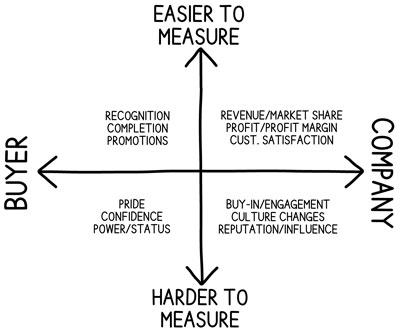|
Without return (R), there is only the investment (I), making it a cost. And the rule for buyers is, the price is always too high.

I'm talking to an agency and we're reviewing their latest proposal. I flip through it and something jumps out.
"The only number in your proposal is the cost," I said. "For your buyer and whoever else is reviewing this proposal, calculating ROI needs two numbers. The investment and the return on that investment. You have one in here. Do you know the other?"
It's something we've talked about before. We look through the last five proposals and, while attractive and impressive, they all come up short when it comes to defining the value of the solution.
"Greg," he said, "I know what you're saying, but it's not that simple. What we help people with is hard to measure. . ." I've heard most of these reasons before. They don't know the measure, or the buyer won't give the information, or any number of challenges. I agree with him, but we can get better at asking.
"Anyway," he said, "we're winning some of these, so it's not all bad."
I'm not one to argue with success, but it doesn't stop me from pulling out this 2x2 grid and reviewing the ways we can help buyers describe the value they expect from our solutions.

Some value is personal. Some is for the business. Some is easy to measure. Some is hard to measure. What we want to do is ask about all of it, because we want our proposals to show a return on the investment, not just an investment. An investment by itself is a cost, and you know the old buyer saying when they see cost, right? The price is too high. Getting better at understanding their R, their Return on the cost, let's us engage in real talk about the price being too high, too low, or just right.
And why go through this? This is what the research says:
- One, it improves close rates.
- Two, it improves customer satisfaction.
- Three, it reduces churn.
- Four, the buyer is going to do the calculation and use it to judge the transaction with or without you. You might as well get an idea of how they'll judge you up front.
The hard part is asking for the information. If the goal is to never send a proposal without an estimate of the ROI, getting there is a challenge. This is where "The Sales Momentum Mindset" comes in. To start, we don't need to do this every time on every proposal, right now. However, we do need to think about it on every proposal right now.
"The last five proposals have no R," I said, "on your next five, let's start by following up on each proposal with a question. I will ask 'did you ask the buyer how they would measure success or where success is going to show up in their business?' each time for five proposals. We're making progress if you can answer yes each time, even if we don't get the info. Will you commit to asking?"
We will eventually reach the goal, but the important thing is to build momentum right now. The way we'll build momentum is with questions, or really, a question, and reacting to the answer. Over and over again.
Make the effort to find where your buyer will look for evidence of success. It will help all areas of your business. I swear.
Good stuff.
|